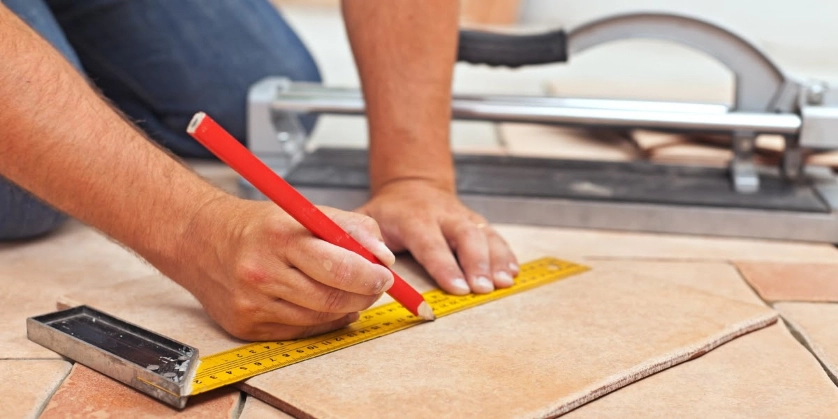Your Guide to Tile Repair

What is more spectacular in your Anne Arundel County home than a glorious backsplash in the kitchen, or stunning floor in the bathroom? It adds the perfect touch of texture and color to any space. Not to mention, it's a perfectly practical way to stop liquids from staining your walls or causing water damage.
Yet, when your tile backsplash, countertop or floor is damaged, it's both unsightly and a safety hazard. Broken, scratched and dented tile is an eyesore, making your otherwise lovely home look dilapidated and unkempt. And, when porcelain, stone or ceramic tile is damaged, the edges are very sharp. You, a family member or your pet could get hurt if they touch it.
Tile's primary role is to keep liquids away from your walls and floors; this includes splashes of tomato sauce, but most importantly, it keeps water away from your drywall and subfloor. Moisture can wreak havoc on your home, causing mold and wood rot to spore and weaken its structural integrity.
As soon as you see damaged pieces, it's important to repair it right away. This keeps your house safe from water damage, your family safe from getting injured, and maintains your home's aesthetic appeal. To learn more about tile repair, the team at Mr. Handyman of Anne Arundel and North PG put together this helpful guide.
What Causes Damaged Tile?
There are surprisingly a few ways that your tiles might break. Some are quite obvious, but others allude to issues below your floor's surface.
Blunt Force from Heavy Objects
This is likely the most obvious source of damage. Although most tiles can withstand up to 250 pounds of pressure, it's still possible they might dent or crack from the weight of heavy objects. For instance, if you're reorganizing your living room and accidentally drop the sofa down too hard, or if you drop a cast iron in your bathroom.
Also, keep in mind that sometimes what seems like a hairline crack or tiny chip might turn into a bigger problem. Once it's weakened, the more weight that’s applied by people, pets and furniture, the more likely it’ll turn into a wider crack.
Cracking in the Subfloor
If you haven't dropped anything heavy recently, or moved your furniture around, and you notice a crack going along multiple tiles then the issue could actually be further down in your floor. Your floor consists of many layers. Often, this includes a layer of concrete. As any professional builder knows, concrete is prone to cracking. This is completely natural, and most builders prepare for this by using control joints to ensure it cracks in a straight line.
Sometimes, the builder might not be very experienced or may have made a mistake and laid your tile along one of these control joints. In that event, when the concrete cracks so will the floor above.
Improperly Installed Joists
Even below your concrete subfloor, there is a layer that could cause problems with your top-floor. Have you noticed your tiles look like they are sagging? You might shake it off as your imagination playing tricks on you. But the truth is, you might be right.
At the very bottom of your floor lay joists. These are supports that carry the weight of everything that goes on top of it—including concrete, insulation, flooring, furniture, people and pets. That's a lot of weight! Joists have to be laid at a specific distance apart from each other. If they're built too far apart, your flooring will have nothing underneath to support it. This will cause it to bend, and eventually, crack.
How to Fix Damaged Tile?
There are two primary ways to fix damaged tile. There is a plethora of information on YouTube about how to DIY tile repair, and if you're a handy person then you may be able to follow along and fix it yourself. Keep in mind that both repair methods require a lot of specialty tools and materials, including grout, a notched trowel, a grout saw, epoxy and more. Be sure you know how to use these tools and materials before trying your DIY project, or you might just end up wasting a lot of time and money. Also, you only get one shot at the repair, so you need to get it done right the first time.
The Two Repair Methods Are:
- Inserting a Replacement: This involves carefully removing the damaged one and replacing it with a new piece. Since tiles are made in batches, it can be tricky to match it directly unless you saved some from the initial installation. This process ensures it will not break again, as it's brand-new.
- Fill the Crack: There are numerous methods to fill a minor crack, but most include using a clear or white epoxy, followed by a layer of paint, and sealed with urethane.
Why Hire Mr. Handyman?
When it comes to getting the job done right the first time, that's something you don't have to worry about when you hire the pros at Mr. Handyman of Anne Arundel and North PG. Although some experienced homeowners might want to try a DIY solution, count on our team of skilled technicians to get your project done efficiently and correctly.
Each of our service technicians has years of experience completing a range of repairs—including tile installation and grout repair. We've helped homeowners throughout Anne Arundel County and North PG, including in Annapolis, Bowie and Crofton. We're highly versatile, skillful and hardworking. Our team has worked with many types of tile, including:
- Porcelain and ceramic
- Natural stone (limestone, granite, marble)
- Luxury materials like glass
Whether you need help with a small, one-time project or a large improvement project, our team is up to the task. To book an appointment today, give us a call.
 Click to call
Click to call


